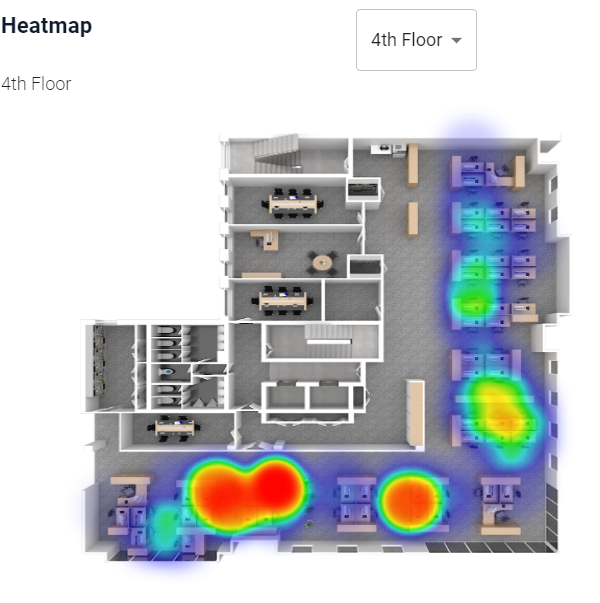Space Optimization: How to Use Heatmaps for Smarter Workspaces
Understanding Space Optimization with Heatmaps
Space optimization is essential for businesses looking to maximize the efficiency of their real estate assets. With the rise of hybrid work, understanding how office space is used is more important than ever. Heatmaps provide a data-driven approach to space management, revealing usage trends and eliminating guesswork.
Consider this visual:
The fourth floor of your HQ office often feels empty, but meeting rooms always seem occupied. Instead of relying on perception, heatmaps allow you to measure space usage objectively, helping businesses make informed decisions about their office layouts.
In this blog, we explore how to gather heatmap data and implement strategic space optimization techniques to create a more effective workplace.
How to Gather Heatmap Data
To generate a heatmap of your office space, you need the right technology. There are two primary methods:
- Space Booking Software – A quick and flexible option, tracking desk and meeting room reservations to generate heatmaps. This approach provides immediate insights into occupancy trends.
- Sensors – These track real-time movement and space usage with high precision, integrating seamlessly with space booking tools. However, sensors require a larger investment and a longer setup time.
Regardless of the technology you choose, ensure heatmaps are integrated into standard analytics, providing real-time space optimization insights rather than static data.
For more details on selecting the best workspace management solutions, visit Capella
How to Use Heatmap Data for Space Optimization
Once you’ve analyzed your heatmap data, you’ll likely find underutilized office space. Whether it’s entire locations, floors, or specific sections, heatmaps help businesses identify opportunities for better space optimization.
Here are three strategies to maximize underused areas:
1. Amalgamation: Creating Synergy Through Consolidation
Amalgamation involves combining smaller office spaces into a larger, unified area to enhance efficiency and collaboration. Heatmaps help with this by:
- Identifying Collaboration Opportunities – Discover where teams interact frequently and place them in shared spaces to boost productivity.
- Improving the In-Office Experience – Consolidating office space can create a more vibrant and engaged work environment.
- Strengthening Workplace Culture – Bringing teams together fosters stronger connections and enhances workplace dynamics.
2. Subletting: Reducing Costs & Maximizing Resources
If your heatmaps reveal low occupancy zones, subletting can be an effective way to cut costs while retaining a presence in your building.
How heatmaps support subletting decisions:
- Identifying Underutilized Spaces – Pinpoint areas with low foot traffic that could be rented to external companies.
- Reducing Costs – Sharing expenses like utilities and maintenance lowers operational costs.
- Maximizing Resources – Transform vacant spaces into revenue-generating assets.
3. Repurposing: Adapting to New Needs
Heatmaps help businesses adapt office spaces to better suit employee needs. Instead of leaving areas vacant, repurpose them based on actual occupancy trends.
Benefits of repurposing spaces:
- Meeting Niche Employee Needs – Convert underutilized areas into quiet zones, collaboration hubs, or creative spaces.
- Enhancing Productivity – Employees thrive in spaces designed for their specific work preferences.
- Improving Retention – A well-designed office helps attract and retain top talent.
Test Before You Optimize
Before making permanent space optimization changes, test the impact first. Try:
- Temporarily shutting down underused areas and consolidating bookings.
- Tracking employee feedback and workflow efficiency.
- Evaluating how changes impact business operations.
This step ensures your space optimization strategy aligns with company needs before committing to major adjustments.
Conclusion
Utilizing heatmaps for space optimization is a game-changer for businesses looking to improve efficiency and reduce costs. By analyzing occupancy trends, companies can implement strategic real estate decisions like amalgamation, subletting, or repurposing spaces. Each of these methods helps streamline operations, enhance collaboration, and make better use of office space.
With heatmaps as your guide, your business can optimize office space intelligently, creating a future-ready workspace that supports productivity and innovation.
🔗 Explore Capella’s Space Optimization Solutions: Visit Capella
